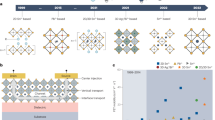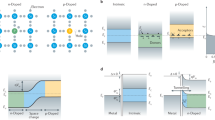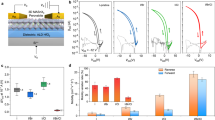Abstract
Investigation of the inherent field-driven charge transport behaviour of three-dimensional lead halide perovskites has largely remained challenging, owing to undesirable ionic migration effects near room temperature and dipolar disorder instabilities prevalent specifically in methylammonium-and-lead-based high-performing three-dimensional perovskite compositions. Here, we address both these challenges and demonstrate that field-effect transistors based on methylammonium-free, mixed metal (Pb/Sn) perovskite compositions do not suffer from ion migration effects as notably as their pure-Pb counterparts and reliably exhibit hysteresis-free p-type transport with a mobility reaching 5.4 cm2 V–1 s−1. The reduced ion migration is visualized through photoluminescence microscopy under bias and is manifested as an activated temperature dependence of the field-effect mobility with a low activation energy (~48 meV) consistent with the presence of the shallow defects present in these materials. An understanding of the long-range electronic charge transport in these inherently doped mixed metal halide perovskites will contribute immensely towards high-performance optoelectronic devices.
This is a preview of subscription content, access via your institution
Access options
Access Nature and 54 other Nature Portfolio journals
Get Nature+, our best-value online-access subscription
$29.99 / 30 days
cancel any time
Subscribe to this journal
Receive 12 print issues and online access
$259.00 per year
only $21.58 per issue
Buy this article
- Purchase on Springer Link
- Instant access to full article PDF
Prices may be subject to local taxes which are calculated during checkout





Similar content being viewed by others
Data availability
The data presented in the paper will be made available after acceptance of the paper on the University of Cambridge repository: https://www.data.cam.ac.uk/repository.
References
Kojima, A., Teshima, K., Shirai, Y. & Miyasaka, T. Organometal halide perovskites as visible-light sensitizers for photovoltaic cells. J. Am. Chem. Soc. 131, 6050–6051 (2009).
Best Research-Cell Efficiency Chart (National Renewable Energy Laboratory, accessed 22 December 2022); https://www.nrel.gov/pv/cell-efficiency.html
Zhao, B. et al. Efficient light-emitting diodes from mixed-dimensional perovskites on a fluoride interface. Nat. Electron. 3, 704–710 (2020).
Stranks, S. D. & Snaith, H. J. Metal-halide perovskites for photovoltaic and light-emitting devices. Nat. Nanotechnol. 10, 391–402 (2015).
Kar, S., Jamaludin, N. F., Yantara, N., Mhaisalkar, S. G. & Leong, W. L. Recent advancements and perspectives on light management and high performance in perovskite light-emitting diodes. Nanophotonics 10, 2103–2143 (2020).
Lei, L., Dong, Q., Gundogdu, K. & So, F. Metal halide perovskites for laser applications. Adv. Funct. Mater. 31, 2010144 (2021).
Deschler, F. et al. High photoluminescence efficiency and optically pumped lasing in solution-processed mixed halide perovskite semiconductors. J. Phys. Chem. Lett. 5, 1421–1426 (2014).
Miao, J. & Zhang, F. Recent progress on highly sensitive perovskite photodetectors. J. Mater. Chem. C 7, 1741–1791 (2019).
Basiricò, L. et al. Detection of X-rays by solution-processed cesium-containing mixed triple cation perovskite thin films. Adv. Funct. Mater. 29, 1902346 (2019).
Dey, K., Roose, B. & Stranks, S. D. Optoelectronic properties of low-bandgap halide perovskites for solar cell applications. Adv. Mater. 33, 2102300 (2021).
Herz, L. M. Charge-carrier mobilities in metal halide perovskites: fundamental mechanisms and limits. ACS Energy Lett. 2, 1539–1548 (2017).
Kagan, C. R., Mitzi, D. B. & Dimitrakopoulos, C. D. Organic-inorganic hybrid materials as semiconducting channels in thin-film field-effect transistors. Science 286, 945–947 (1999).
Matsushima, T. et al. Solution-processed organic–inorganic perovskite field-effect transistors with high hole mobilities. Adv. Mater. 28, 10275–10281 (2016).
Matsushima, T. et al. N-channel field-effect transistors with an organic-inorganic layered perovskite semiconductor. Appl. Phys. Lett. 109, 253301 (2016).
Mitzi, D. B. et al. Hybrid field-effect transistor based on a low-temperature melt-processed channel layer. Adv. Mater. 14, 1772–1776 (2002).
Reo, Y. et al. Effect of monovalent metal iodide additives on the optoelectric properties of two-dimensional Sn-based perovskite films. Chem. Mater. 33, 2498–2505 (2021).
Zhu, H. et al. High-performance and reliable lead-free layered-perovskite transistors. Adv. Mater. 32, 2002717 (2020).
Shao, S. et al. Field-effect transistors based on formamidinium tin triiodide perovskite. Adv. Funct. Mater. 31, 2008478 (2021).
Zhu, H. et al. High-performance hysteresis-free perovskite transistors through anion engineering. Nat. Commun. 13, 1741 (2022).
Liu, A. et al. High-performance inorganic metal halide perovskite transistors. Nat. Electron. 5, 78–83 (2022).
Senanayak, S. P. et al. Understanding charge transport in lead iodide perovskite thin-film field-effect transistors. Sci. Adv. 3, e1601935 (2017).
Wang, J. et al. Investigation of electrode electrochemical reactions in CH3NH3PbBr3 perovskite single-crystal field-effect transistors. Adv. Mater. 31, 1902618 (2019).
Yusoff, A. R. B. M. et al. Ambipolar triple cation perovskite field effect transistors and inverters. Adv. Mater. 29, 1602940 (2017).
Senanayak, S. P. et al. A general approach for hysteresis-free, operationally stable metal halide perovskite field-effect transistors. Sci. Adv. 6, eaaz4948 (2020).
Chin, X. Y., Cortecchia, D., Yin, J., Bruno, A. & Soci, C. Lead iodide perovskite light-emitting field-effect transistor. Nat. Commun. 6, 7383 (2015).
She, X.-J. et al. A solvent-based surface cleaning and passivation technique for suppressing ionic defects in high-mobility perovskite field-effect transistors. Nat. Electron. 3, 694–703 (2020).
Mei, Y., Zhang, C., Vardeny, Z. V. & Jurchescu, O. D. Electrostatic gating of hybrid halide perovskite field-effect transistors: balanced ambipolar transport at room-temperature. MRS Commun. 5, 297–301 (2015).
Conings, B. et al. Intrinsic thermal instability of methylammonium lead trihalide perovskite. Adv. Energy Mater. 5, 1500477 (2015).
Xiao, K. et al. All-perovskite tandem solar cells with 24.2% certified efficiency and area over 1 cm2 using surface-anchoring zwitterionic antioxidant. Nat. Energy 5, 870–880 (2020).
Euvrard, J., Yan, Y. & Mitzi, D. B. Electrical doping in halide perovskites. Nat. Rev. Mater. 6, 531–549 (2021).
Konstantakou, M. & Stergiopoulos, T. A critical review on tin halide perovskite solar cells. J. Mater. Chem. A 5, 11518–11549 (2017).
Meggiolaro, D., Ricciarelli, D., Alasmari, A. A., Alasmary, F. A. S. & De Angelis, F. Tin versus lead redox chemistry modulates charge trapping and self-doping in tin/lead iodide perovskites. J. Phys. Chem. Lett. 11, 3546–3556 (2020).
Goyal, A. et al. Origin of pronounced nonlinear band gap behavior in lead–tin hybrid perovskite alloys. Chem. Mater. 30, 3920–3928 (2018).
Rajagopal, A., Stoddard, R. J., Hillhouse, H. W. & Jen, A. K. Y. On understanding bandgap bowing and optoelectronic quality in Pb–Sn alloy hybrid perovskites. J. Mater. Chem. A 7, 16285–16293 (2019).
Ma, F. et al. Stable α/δ phase junction of formamidinium lead iodide perovskites for enhanced near-infrared emission. Chem. Sci. 8, 800–805 (2017).
Choi, H. H., Cho, K., Frisbie, C. D., Sirringhaus, H. & Podzorov, V. Critical assessment of charge mobility extraction in FETs. Nat. Mater. 17, 2–7 (2018).
Galkowski, K. et al. Excitonic properties of low-band-gap lead–tin halide perovskites. ACS Energy Lett. 4, 615–621 (2019).
Schueller, E. C. et al. Crystal structure evolution and notable thermal expansion in hybrid perovskites formamidinium tin iodide and formamidinium lead bromide. Inorg. Chem. 57, 695–701 (2018).
Stoumpos, C. C., Malliakas, C. D. & Kanatzidis, M. G. Semiconducting tin and lead iodide perovskites with organic cations: phase transitions, high mobilities, and near-infrared photoluminescent properties. Inorg. Chem. 52, 9019–9038 (2013).
Bandara, R. M. I. et al. Tin(iv) dopant removal through anti-solvent engineering enabling tin based perovskite solar cells with high charge carrier mobilities. J. Mater. Chem. C 7, 8389–8397 (2019).
Klug, M. T. et al. Metal composition influences optoelectronic quality in mixed-metal lead–tin triiodide perovskite solar absorbers. Energy Environ. Sci. 13, 1776–1787 (2020).
Milot, R. L., Eperon, G. E., Snaith, H. J., Johnston, M. B. & Herz, L. M. Temperature-dependent charge-carrier dynamics in CH3NH3PbI3 perovskite thin films. Adv. Funct. Mater. 25, 6218–6227 (2015).
Milot, R. L. et al. The effects of doping density and temperature on the optoelectronic properties of formamidinium tin triiodide thin films. Adv. Mater. 30, 1804506 (2018).
Gélvez-Rueda, M. C., Renaud, N. & Grozema, F. C. Temperature dependent charge carrier dynamics in formamidinium lead iodide perovskite. J. Phys. Chem. C 121, 23392–23397 (2017).
Kresse, G. & Furthmüller, J. Efficient iterative schemes for ab initio total-energy calculations using a plane-wave basis set. Phys. Rev. B 54, 11169–11186 (1996).
Kresse, G. & Joubert, D. From ultrasoft pseudopotentials to the projector augmented-wave method. Phys. Rev. B 59, 1758–1775 (1999).
Perdew, J. P. et al. Restoring the density-gradient expansion for exchange in solids and surfaces. Phys. Rev. Lett. 100, 136406 (2008).
Ghosh, D., Smith, A. R., Walker, A. B. & Islam, M. S. Mixed A-cation perovskites for solar cells: atomic-scale insights into structural distortion, hydrogen bonding, and electronic properties. Chem. Mater. 30, 5194–5204 (2018).
Even, J., Pedesseau, L., Jancu, J.-M. & Katan, C. Importance of spin–orbit coupling in hybrid organic/inorganic perovskites for photovoltaic applications. J. Phys. Chem. Lett. 4, 2999–3005 (2013).
Ghosh, D., Aziz, A., Dawson, J. A., Walker, A. B. & Islam, M. S. Putting the squeeze on lead iodide perovskites: pressure-induced effects to tune their structural and optoelectronic behavior. Chem. Mater. 31, 4063–4071 (2019).
Steiner, S., Khmelevskyi, S., Marsmann, M. & Kresse, G. Calculation of the magnetic anisotropy with projected-augmented-wave methodology and the case study of disordered Fe1–xCox alloys. Phys. Rev. B 93, 224425 (2016).
Grimme, S., Antony, J., Ehrlich, S. & Krieg, H. A consistent and accurate ab initio parametrization of density functional dispersion correction (DFT-D) for the 94 elements H-Pu. J. Chem. Phys. 132, 154104 (2010).
Acknowledgements
S.P.S. acknowledges funding support from the Royal Society through the Newton Alumni Fellowship (AL\211004, AL\201019 and AL\191021), Science and Engineering Research Board (SERB-SRG/2020/001641 and IPA/2021/000096), Department of Atomic Energy (DAE), Government of India. K.D. acknowledges the support of the Cambridge Trust and SERB (Government of India) in the form of a Cambridge India Ramanujan Scholarship. K.D. thanks F. Lang for useful discussions on PL measurements. This work received funding from the European Research Council under the European Union’s Horizon 2020 research and innovation programme (HYPERION, grant agreement no. 756962). R.H.F. and R.S. acknowledge funding and support from the SUNRISE project (EP/P032591/1). R.S. acknowledges a Newton International Fellowship from the Royal Society. J.L.M.D. and W.L. thank the UK Royal Academy of Engineering, grant CiET1819_24; Engineering and Physical Sciences Research Council (EPSRC) grants EP/N004272/1, EP/P007767/1 and EP/L011700/1; and the Winton Programme for the Physics of Sustainability. W.L. acknowledges B. Welland for useful discussions. B.R. acknowledges EPSRC, grant number EP/T02030X/1. S.J.Z. acknowledges support from the Polish National Agency for Academic Exchange within the Bekker programme (grant no. PPN/BEK/2020/1/00264/U/00001). N.T. acknowledges the use of resources of the Center for Functional Nanomaterials, which is a US Department of Energy Office of Science User Facility, at Brookhaven National Laboratory under contract no. DE-SC0012704. D.G. thanks the Center for Integrated Nanotechnologies, a US Department of Energy and Office of Basic Energy Sciences user facility, at Los Alamos National Laboratory, for providing computational facilities. Y.Z. thanks the Chinese Scholarship Council and the EPSRC Centre for Doctoral Training in Graphene Technology for financial support. H.S. thanks the Royal Society for support through a Royal Society Research Professorship (RP\R1\201082). S.D.S. acknowledges support from the Royal Society and Tata Group (UF150033).
Author information
Authors and Affiliations
Contributions
S.P.S. and K.D. conceived the idea and designed the experimental plan with input from S.D.S. and H.S.; K.D. optimized the perovskite films used for the measurements and performed the spectroscopic and structural measurements. S.P.S. fabricated the FETs and performed all the FET measurements and bias stress stability measurements. R.S. performed the PL mapping measurement and discussed it with S.P.S., K.D. and R.H.F.; W.L. and J.L.M.D. performed and analysed the XPS measurements. D.G. carried out the first-principles density functional theory calculations. S.P.S. and Y.Z. performed the switching measurement, the contact modification and the associated FET measurements. B.R. measured the top-view scanning electron microscopy of the perovskite films. S.J.Z. and Z.A.-G. conducted the PDS measurements. W.W. assisted with the Hall measurements. N.T. performed the grazing incidence wide-angle X-ray scattering measurements. Y.Z. and N.T. fabricated the Hall patterns. S.P.S. and K.D. interpreted all the data related to device measurements and material characterization, with input from all authors. All authors discussed and revised the manuscript.
Corresponding authors
Ethics declarations
Competing interests
S.D.S. is a cofounder of Swift Solar. The remaining authors declare no competing interests.
Peer review
Peer review information
Nature Materials thanks the anonymous reviewers for their contribution to the peer review of this work.
Additional information
Publisher’s note Springer Nature remains neutral with regard to jurisdictional claims in published maps and institutional affiliations.
Supplementary information
Rights and permissions
Springer Nature or its licensor (e.g. a society or other partner) holds exclusive rights to this article under a publishing agreement with the author(s) or other rightsholder(s); author self-archiving of the accepted manuscript version of this article is solely governed by the terms of such publishing agreement and applicable law.
About this article
Cite this article
Senanayak, S.P., Dey, K., Shivanna, R. et al. Charge transport in mixed metal halide perovskite semiconductors. Nat. Mater. 22, 216–224 (2023). https://doi.org/10.1038/s41563-022-01448-2
Received:
Accepted:
Published:
Issue Date:
DOI: https://doi.org/10.1038/s41563-022-01448-2



